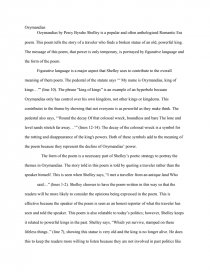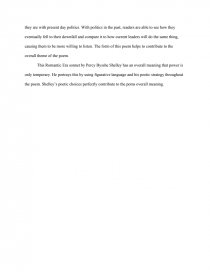Ozymandias by Percy Bysshe Shelley
Essay by sierramoore • November 12, 2017 • Essay • 461 Words (2 Pages) • 1,189 Views
Ozymandias
Ozymandias by Percy Bysshe Shelley is a popular and often anthologized Romantic Era poem. This poem tells the story of a traveler who finds a broken statue of an old, powerful king. The message of this poem, that power is only temporary, is portrayed by figurative language and the form of the poem.
Figurative language is a major aspect that Shelley uses to contribute to the overall meaning of them poem. The pedestal of the statute says ‘“ My name is Ozymandias, king of kings…’” (line 10). The phrase “king of kings” is an example of an hyperbole because Ozymandias only has control over his own kingdom, not other kings or kingdoms. This contributes to the theme by showing that not everyone is as powerful as they make think. The pedestal also says, ‘“Round the decay Of that colossal wreck, boundless and bare The lone and level sands stretch far away…’” (lines 12-14). The decay of the colossal wreck is a symbol for the rotting and disappearance of the king's powers. Both of these symbols add to the meaning of the poem because they represent the decline of Ozymandias’ power.
The form of the poem is a necessary part of Shelley’s poetic strategy to portray the themes in Ozymandias. The story told in this poem is told by quoting a traveler rather than the speaker himself. This is seen when Shelley says, “I met a traveller from an antique land Who
said:...” (lines 1-2). Shelley chooses to have the poem written in this way so that the readers will be more likely to consider the opinions being expressed in the poem. This is effective because the speaker of the poem is seen as an honest reporter of what the traveler has seen and told the speaker. This poem is also relatable to today’s politics; however, Shelley keeps it related to powerful kings in the past. Shelley says, “Which yet survive, stamped on these lifeless things..” (line 7), showing this statue is very old and the king is no longer alive. He does this to keep the readers more willing to listen because they are not involved in past politics like they are with present day politics. With politics in the past, readers are able to see how they eventually fell to their downfall and compare it to how current leaders will do the same thing, causing them to be more willing to listen. The form of this poem helps to contribute to the overall theme of the poem.
This Romantic Era sonnet by Percy Bysshe Shelley has an overall meaning that power is only temporary. He portrays this by using figurative language and his poetic strategy throughout the poem. Shelley’s poetic choices perfectly contribute to the poms overall meaning.
...
...

